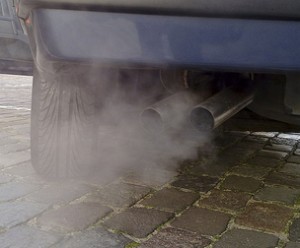“Our ozone problem is the result of the combination of population, climate, terrain and industry,” with car exhaust as the main source of the pollutant in California, Dimitri Stanich, a spokesman for the California Air Resources Board, wrote in an email. “California has historically had the worst air pollution in the union. In the 1940s, there were smog events in the L.A. area where residents couldn’t see a city block.”
Ozone is created when pollutants from cars, power plants and other sources interact with sunlight.
To address ozone pollution, the air resources board requires car manufacturers to meet more stringent emission standards and regulates some chemical-based consumer products that may contribute to ozone during evaporation.
In its new study, EPA researchers exposed 23 healthy young adults to two-hour sessions of both clean air and ozone-polluted air at levels about two times greater than what residents in China or Mexico experience during the middle of the day. After exposure to the pollutant, the study subjects saw an increase in various cardiovascular indicators that could result in heart problems in people with heart disease, including vascular inflammation and a reduced ability to dissolve artery-blocking blood clots.
Though studies of ozone and human health abound, the new EPA study, published in the American Heart Association journal Circulation, is among the first to use human volunteers to explain how ozone can potentially kill people by causing heart attacks. Previous epidemiological studies have shown a connection using statistical analyses.
“It’s the strongest evidence that there is a true causal connection” between ozone exposure and heart health, and confirms and expands what has been suggested in previous studies, said Douglas Dockery, an environmental epidemiology professor at Harvard’s School of Public Health.
Health experts said that the latest EPA study is an important contribution to determining the extent of the relationship between ozone exposure and cardiovascular problems – an issue that is far from scientifically settled.
A larger, 90-person study among the elderly was recently launched by the Boston-based Health Effects Institute in conjunction with UC San Francisco and two other universities.
“There is not a universal set of studies that say, ‘Yeah, ozone definitely contributes to cardiovascular effects,' " said Dan Greenbaum of the Health Effects Institute. "But that may be because we have not looked at it the right way, and that is what we are trying to do with this study (of the elderly).”
Joe Lyou, a governing board member of the South Coast Air Quality Management District and the CEO and president of the Coalition for Clean Air, said more could be done at a policy level to address the health impacts of ozone pollution.
“We need to move toward zero and near-zero emission transportation for both people and freight,” he said in an email. “In order to meet our clean air standards, we have to focus on the combustion of petrochemical fuels and identify ways to minimize and eliminate it. If we do it right, we can increase energy efficiency, reduce our dependency upon foreign oil and save boatloads of money.”
The EPA is currently reviewing the national air quality standards for ozone and will issue a final rule in 2014. In preparation, a draft scientific assessment was recently released by the agency for public comment, and it states that the current health research is “suggestive of a causal relationship” between the pollutant and cardiovascular effects. The agency’s Clean Air Scientific Advisory Committee Ozone Review Panel, however, had previously recommended that the EPA upgrade this determination to “likely to be a causal relationship.”
In September, the Obama administration rejected a proposed rule from the EPA to tighten the federal air quality standards related to ozone pollution. In a statement, the president cited the “importance of reducing regulatory burdens and regulatory uncertainty, particularly as our economy continues to recover.”
More information
The U.S. Environmental Protection Agency has more on how to limit ozone exposure.
